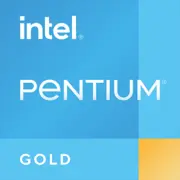Intel Pentium Gold G7400

Intel Pentium Gold G7400: Budget Processor for Everyday Tasks in 2025
Architecture, Performance, and Features to Consider
Key Specifications: Alder Lake in a Compact Format
The Intel Pentium Gold G7400 processor, released in 2022, remains a relevant budget solution even in 2025. It is built on the hybrid Alder Lake architecture but, unlike the top-end Core i5/i7, it utilizes only Performance-cores (P-cores). Here are the key parameters:
- Manufacturing Process: Intel 7 (10nm Enhanced SuperFin).
- Cores/Threads: 2/4.
- Base Frequency: 3.7 GHz (without Turbo Boost).
- Cache: 6 MB L3.
- TDP: 46 W.
- Integrated Graphics: Intel UHD Graphics 710.
Architecture Features:
- Support for PCIe 5.0 (up to 16 lanes) and DDR5/DDR4.
- Intel Thread Director technology for optimizing workloads (relevant in Windows 11/12).
- Absence of Efficient-cores (E-cores) — focus on energy efficiency with a small number of cores.
Performance:
- Geekbench 6: 2050 (Single-Core), 4405 (Multi-Core).
- Compared to the Pentium Gold G6400 (Comet Lake, 2020): a 25% increase in single-threaded tasks.
- Suitable for office applications, web browsing, and light multitasking (e.g., document work + HD video).
Compatible Motherboards: LGA 1700 Socket and Chipsets
The Pentium G7400 uses the LGA 1700 socket, supported by 600 and 700 series chipsets:
- H610: Budget option ($70–90). Examples: ASUS Prime H610M-E, Gigabyte H610M S2H.
- Limitations: no RAM overclocking, 1 PCIe 4.0 slot.
- B660/B760 ($100–130): The best choice for G7400. Supports DDR5 (optional), more USB/SATA ports. Example: MSI PRO B760M-P.
- H670/Z690/Z790: Excessive for Pentium, but suitable for future upgrades.
Tip: To save money, choose H610 with DDR4. If planning to move to DDR5 — go for B760.
Supported Memory: DDR4 vs DDR5
The processor is compatible with DDR4-3200 and DDR5-4800, but the choice depends on the motherboard:
- DDR4: Optimal for budget builds. 16 GB (2×8 GB) DDR4-3200 will cost around $40–50.
- DDR5: More expensive ($60–70 for 16 GB), but provides a 5–10% performance boost in bandwidth-sensitive tasks (e.g., rendering).
Recommendation: For an office PC or media center, DDR4-3200 is more than sufficient.
Power Supply: Power Calculation
With a TDP of 46 W and integrated graphics, a system with G7400 consumes ~100–150 W under load. Recommendations:
- Power Supply Wattage: 400–500 W (e.g., EVGA 500 BR, $45).
- Certification: 80+ Bronze or higher.
- Note: If planning to use a discrete graphics card (e.g., GTX 1650), choose a PSU rated for 500–600 W.
Pros and Cons of Pentium Gold G7400
Advantages:
1. Energy Efficiency: Ideal for compact PCs (Mini-ITX) or systems with passive cooling.
2. Price: $85–90 (new) — one of the most affordable processors of 2025.
3. Modern Technologies: Support for PCIe 5.0 and DDR5 (on compatible motherboards).
Disadvantages:
1. 2 Cores: Multithreaded tasks (video editing, 3D rendering) are completed slowly.
2. Weak Graphics: UHD 710 only handles HD video and older games.
3. No Turbo Boost: Fixed frequency limits performance.
Use Cases: Where the G7400 Shines
1. Office Tasks: Working with Excel, Word, browsing (up to 20 tabs).
2. Media Center: Streaming 4K video via HDMI 2.0, music playback.
3. Light Gaming: Minecraft, Dota 2, CS:GO on low settings (30–45 FPS).
4. Home Server: NAS or router due to low TDP.
Practical Example:
A user built a PC with G7400, ASRock H610M-ITX, and 16 GB DDR4. The system is used for document work and watching Netflix — power consumption at idle is only 25 W.
Comparison with Competitors: AMD vs Intel
AMD Ryzen 3 5300G ($100–110):
- 4 cores/8 threads, Vega 6 (graphics stronger than UHD 710).
- Better in multithreaded tasks (+30% in Cinebench R23), but more expensive.
Intel Core i3-12100 ($120–130):
- 4 cores/8 threads, UHD 730.
- Higher performance in games and applications, but 40% more in price.
Conclusion: The Pentium G7400 only wins in the budget segment. If multithreading is needed — better to pay more for the Ryzen 3.
Practical Assembly Tips
1. Cooler: Stock cooler is sufficient, but for quieter operation, consider the DeepCool GAMMAXX 400 V2 ($20).
2. Storage: An SSD is a must (e.g., Kingston NV2 500 GB, $35).
3. Case: A compact Fractal Design Core 1100 ($50) is suitable.
4. Compatibility: Check for LGA 1700 support for the cooler and HDMI/DisplayPort availability on the motherboard.
Final Conclusion: Who is the Pentium Gold G7400 Suitable For?
This processor is an ideal choice for:
- Office PCs: Quick document and browser work.
- Home Media Centers: Connection to a TV for Netflix and YouTube.
- Budget Builds: If the goal is to minimize costs (a complete system will cost around $300–400).
Why is it still relevant in 2025?
Low price, support for DDR5/PCIe 5.0 (for future upgrades), and energy efficiency make it the best option for non-demanding users. However, for gaming or professional tasks, consider the Ryzen 3 or Core i3.
Basic
CPU Specifications
Memory Specifications
GPU Specifications
Miscellaneous
Benchmarks
Compared to Other CPU
Share in social media
Or Link To Us
<a href="https://cputronic.com/cpu/intel-pentium-gold-g7400" target="_blank">Intel Pentium Gold G7400</a>